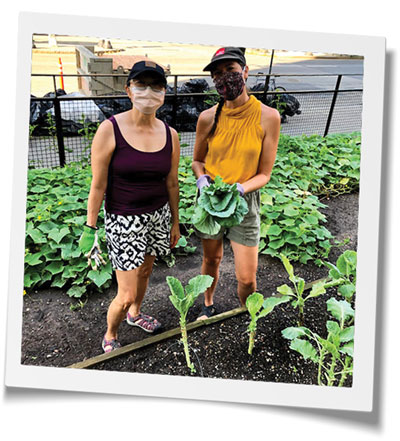Garden Nation: Extension services are an excellent, free resource for gardeners
Spurred by COVID, 18.3 million have turned to gardening—cultivating the benefits of physical activity, greater connection to nature, homegrown food, and restorative, sustainable practices, aiding the environment.
 |
|
The author (left) with Melissa Metrick, manager of the NYU Urban Fam Lab, |
Buffeted by the headlines and crises striking globally and nationally, I am troubled. I sense a similar tenor among family, friends, and the communities to which I belong. And I’m guessing you might be feeling the same. Add to that the demands of work, to produce, and endure even more.
As a trend, the concept of “self-care” is an uncomfortable one for me. There’s the inherent assumption of privilege and attendant commercialism. Culturally, too, I am predisposed to suck it up. That’s the gist of gaman, a familiar concept to Japanese Americans and one in which I was raised. Yet the stressors on personal health—physical, mental, spiritual—are upon us and beg attention to well-being, to do better by ourselves so we can be there for others.
And so we pause, and step outside.
“Everything that slows us down and forces patience, everything that sets us back into the slow circles of nature, is a help,” as May Sarton wrote. “Gardening is an instrument of grace.”
Spurred by COVID, legions have flocked to gardening—to the tune of 18.3 million new tillers of soil, according to the National Gardening Association—garnering the benefits of physical activity, greater connection to nature, homegrown food, and restorative, sustainable practices, aiding the environment.
Personal, sustainable practice
“It was exercise, it was nutrition, fresh air and sunshine. I would see many of the same people when I went, so it was community,” says Edi Campbell, research and instruction librarian at Indiana State University, who tends a plot on campus.
“I like gardening not only for the community but for nutritional benefits, knowing what’s going in my food. I was involved with local organizations [during COVID], delivering food to people in need. I became more aware of how local food banks work and eventually more interested in sustainable food practices from a social justice perspective, from no-till practices to protect the soil to protecting local farmers.”
Seeds were scarce in 2020 and continue to be so this year for me (an avid gardener for most of my adult life). So digging in the dirt seems to have taken hold. Indeed, 89 percent of gardeners plan to increase the activity post-pandemic, reports NGA. The intent to garden more is higher among millenials, gardeners with children, apartment dwellers, and gardeners of color.
George Ball, chairman of W. Atlee Burpee Co, is seeing a double-digit increase in seed and plant sales for the third year running in 2022. But numbers can fluctuate, he writes in the Wall Street Journal. “Qualitative trends, by contrast, signify shifting cultural values, priorities and practices. This transformation will shape American culture for generations.”
That was the impetus of the cooperative extension service, the best kept secret of accurate information about gardening and practical, localized advice, offered free of charge. Founded by a 1914 act of Congress to “advance agriculture, the environment, human health and well-being, and communities,” the extension service tasks land-grant universities with providing to the public research-based, informal learning opportunities in various subjects, from cooking and gardening to health and parenting.
The program is administered by the 1862 public universities around the country; the 1890 historically black colleges and universities (HBCUs) and Tuskegee University; and the 1994 tribal colleges and universities.
Find your local extension service in the college partners directory.
 Resources
Resources
Share yours in the comments.
Extension Master Gardener program
“The Extension Master Gardener Volunteer Program (EMGV) estimated at least 84,700 EMG volunteers (2020) throughout the United States and Washington, D.C, contributed 3.1 million hours educating others, and helped people use gardening to grow food, improve their physical and mental health, and address environmental issues.”
The Botany of Desire
By Michael Pollan
Braiding Sweetgrass
By Robin Wall Kimmerer
Farming While Black
By Leah Penniman
The Well-Tended Perennial Garden: The Essential Guide to Planting and Pruning Techniques
By Tracy Disabato-Aust
Growing Practice: Library Gardens
By Erica Freudenberger on Library Journal
13 Books About Gardening for the Whole Family | Summer Reading 2021
By SLJ reviews


RELATED
The job outlook in 2030: Librarians will be in demand
The job outlook in 2030: Librarians will be in demand
ALREADY A SUBSCRIBER? LOG IN
We are currently offering this content for free. Sign up now to activate your personal profile, where you can save articles for future viewing






Add Comment :-
Be the first reader to comment.
Comment Policy:
Comment should not be empty !!!